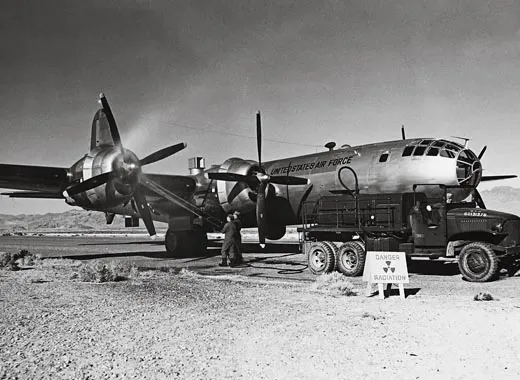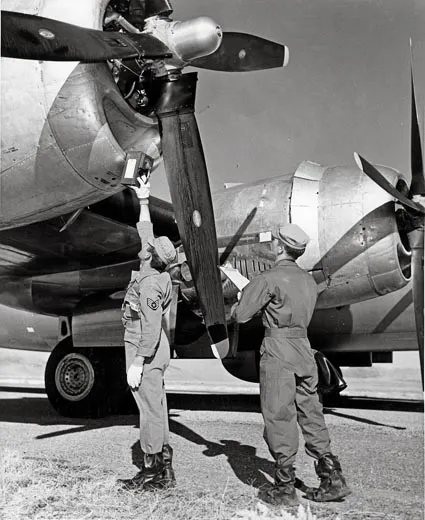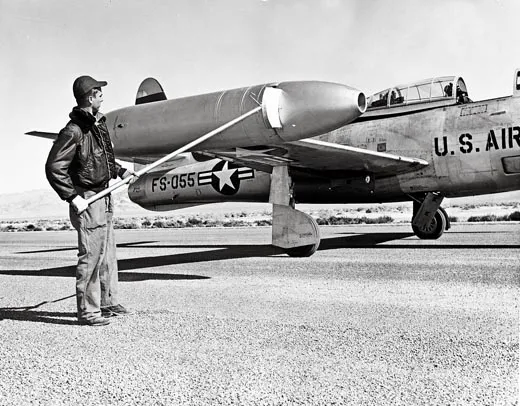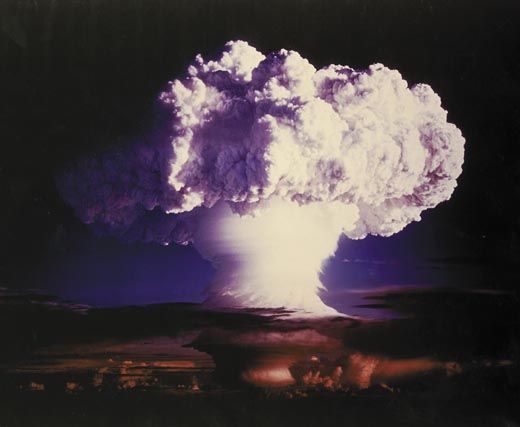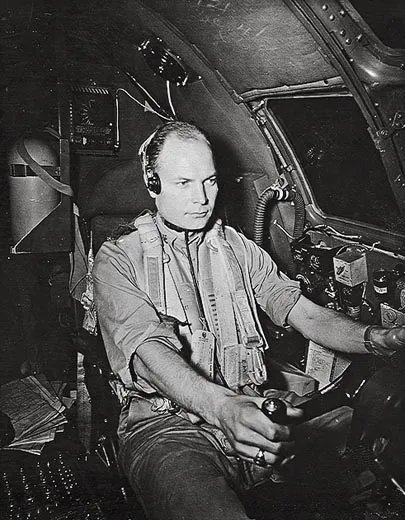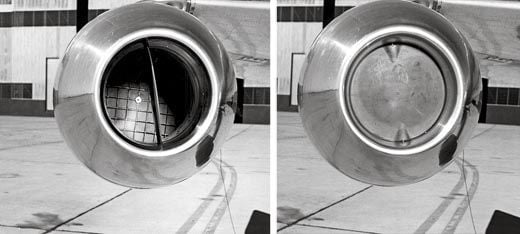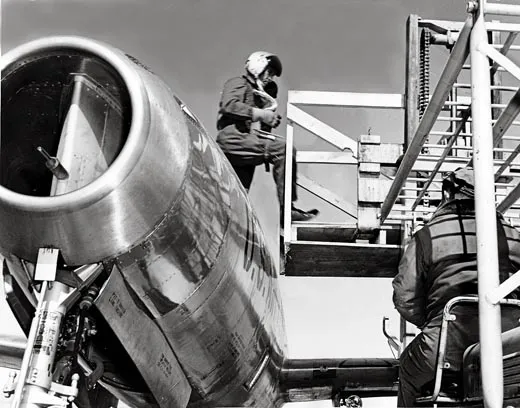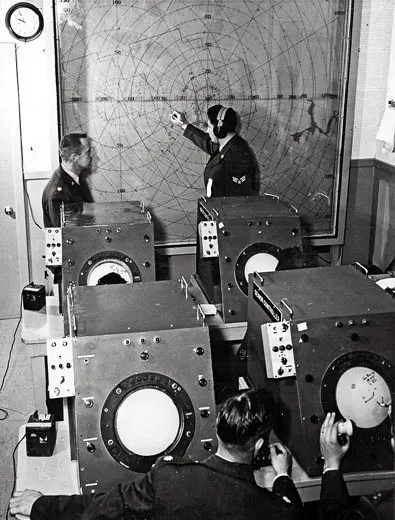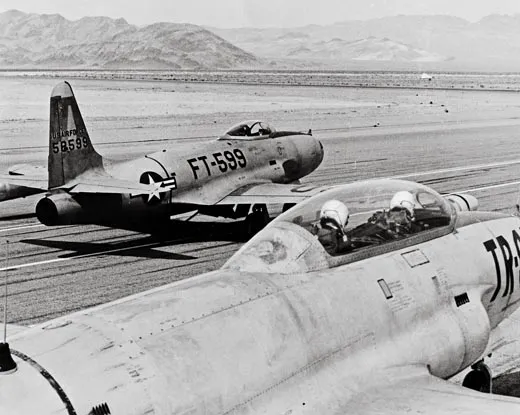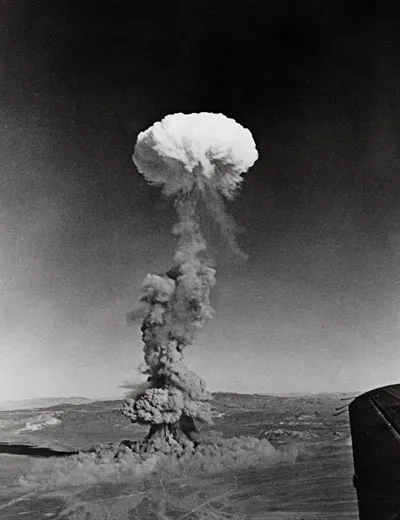Into the Mushroom Cloud
Most pilots would head away from a thermonuclear explosion.
/https://tf-cmsv2-smithsonianmag-media.s3.amazonaws.com/filer/5b/4b/5b4b6a95-9d24-4038-8030-0ce93b77b1f9/ivymikeb1600c20.jpg)
He wasn’t supposed to do it, but on May 15, 1948, Lieutenant Colonel Paul H. Fackler, commanding officer of the U.S. Air Force 514th Reconnaissance Squadron Weather, flew his airplane into the seething mushroom cloud of an atomic bomb detonation.
As part of Zebra, the final shot of America’s second series of atomic tests at Enewetak atoll in the Pacific, Fackler had the job of tracking the atomic cloud from at least 10 miles away, hoping that special filters attached to the airplane would catch samples of the radioactive debris. But as he pulled away from the enormous roiling cloud in a climbing turn to the left, Fackler suddenly found his weather reconnaissance Boeing WB-29 inside a small finger-like projection of the main cloud.
“No one keeled over dead, and no one got sick,” Fackler reported later, according to History of Air Force Atomic Cloud Sampling, a government document published in January 1963. He promptly left the cloud and continued his normal flight profile until his radiation safety officer, sitting in the B-29’s nose monitoring radiation levels, announced the crew had reached their exposure limit: 100 milliroentgens, the amount a person receives annually from naturally occurring radiation from the sun and the soil. It was time to break off and head home to the air base on Kwajalein, in the Marshall Islands. Fackler flew through a few rainshowers to wash off radioactive particles.
Aside from the unstated objective of geopolitical saber-rattling, the main purpose of atomic bomb tests was to try out new weapon designs and improve existing bombs. Analyzing the tiny particles of fallout, trace elements, and short-lived radioisotopes unleashed by the nuclear reactions was the only way to get definitive data on just what had happened inside the multi-million-degree heart of an atomic explosion. But collecting that debris in the aftermath of the explosion was a challenge.
During the first postwar test series, Operation Crossroads in 1946, specially trained pilots in mothership aircraft guided unmanned drones through clouds of two consecutive explosions from a safe distance. The drones, retired Boeing B-17 bombers and Grumman F6F fighters, had boxes mounted on the fuselage or wings, lined with filter paper designed to catch radioactive particles.
Controlling the drones was tricky even under the best conditions, much less in the turbulence following a nuclear blast. Drones often crashed or went astray, and even when everything worked properly, they couldn’t always collect the high-quality samples craved by the physicists and radio-chemists at Los Alamos labs in New Mexico and Lawrence Livermore laboratory in California. All a controller could do was point his drone at the cloud and send it through blindly, hoping that by sheer luck the drone would catch a good sample and survive the landing.
But Fackler’s stunt—whether purposeful or accidental, no one ever knew for sure—had raised an intriguing prospect. By the time the United States began the Ranger series of atomic tests at the new Nevada test site in 1951, Fackler and some supportive colleagues had convinced the military and the Atomic Energy Commission to try manned sampling flights. Monitoring aircraft could vector manned aircraft into the parts of a cloud most likely to yield good samples, and manned craft could respond to rapidly changing conditions much faster than a remote-controlled craft.
The second atomic bomb to detonate in the United States was triggered at 5:45 a.m. on January 27, 1951 (Trinity, the first, exploded near Alamogordo, New Mexico, on July 16, 1945), and at the time, Fackler was piloting a WB-29 toward the mushroom cloud. He depressurized the aircraft cabin and the crew went on 100 percent oxygen to avoid inhaling radioactive dust. Then Fackler took the aircraft through the cloud. He made a second pass, and then the radiation safety officer told him they were nearing their milliroentgen limit—the mission was over. Another sampling aircraft followed Fackler’s through each of Operation Ranger’s four remaining atomic blasts.
The flights were pronounced a success, and what had begun as a simple pilot error, then explored as a cautious experiment, became a vital element of America’s nuclear weapons program. The sampling flights continued through further tests in Nevada, with the teams perfecting techniques and equipment, while Fackler pushed to establish a dedicated cloud sampling unit.
Meanwhile, the hydrogen age was about to dawn.
As Operation Ivy started in late 1952, the sampling flights had largely transitioned from relatively slow prop-driven aircraft to jets, whose greater speed gave crews less time to hang around in the cloud. They could also quickly reach higher altitudes, an important consideration for testing H-bomb detonations, which produce much wider and taller clouds.
When the world’s first hydrogen weapon, in a test designated “Mike,” wiped out the Marshallese island of Elugelab on November 1, 1952, four F-84G fighters carrying sample collection equipment on their wingtips were already in the air. Designated Red Flight and led by Lieutenant Colonel Virgil Meroney, the jets arrived in the area of the bomb cloud about an hour and a half after detonation.
Under instructions from the Convair B-36 sampler control aircraft circling some distance away, Meroney and his wingman penetrated the mushroom cloud’s stem at about 40,000 feet. (As predicted, the main cloud, which began forming at about 55,000 feet, was too high for an aircraft to reach. Samples from the stem would have to do.) Immersed in the dull red glow of the cloud interior, Meroney watched all his radiation instruments peg to their maximum readings. After about five minutes inside, he and his wingman executed a 90-degree turn and escaped.
Then came the rest of Red Flight: Red 3 with Captain Bob Hagan, and his wingman, Red 4, Captain Jimmy Robinson. Hagan calls the cloud “dark and boiling.”
“While we were going through the cloud, Robinson became disoriented and spun out,” Hagan recalls. Apparently, as Robinson pulled his airplane into a tight turn to escape what his instruments told him was a particularly hot part of the cloud, his autopilot disengaged, and as the jet stalled and lost altitude, he briefly lost control. Flight leader Meroney later reported hearing heavy breathing over the radio, as if Robinson had been holding down his mike button while fighting to control the aircraft. After Robinson reported that he had recovered at 20,000 feet, Meroney ordered him and Hagan to leave the cloud and rendezvous.
“I continued on out of the cloud and then went down to 20,000 feet to try to find him, but that didn’t work,” Hagan remembers. “There was a refueling tanker there but they couldn’t find us.” Electromagnetic aftereffects from the H-bomb explosion were also wreaking havoc with their navigational and radio equipment, while their fuel supply dissipated. After being forced to spend almost an hour at lower altitude, where fuel efficiency decreases, Hagan and Robinson had eaten into their scarce reserves. “I decided we better head for a runway somewhere, and Enewetak was the only one that was around,” Hagan says. He managed to pick up a radio beacon from the island and started off. Soon after, Robinson caught the beacon and followed Hagan.
Pacific cloud sampling missions had greater flying distances, so fuel was tight, and with F-84s unable to carry wingtip fuel tanks—that was where the cloud sampling filters were mounted—fuel capacity was even more limited. “When we got to Enewetak, my gas gauge was on empty,” Hagan says. “Luckily on final [approach], I was able to set up a pattern and land without fuel, deadstick.” On the hard landing, the right tire blew out.
Robinson wasn’t as lucky. He reported to Enewetak tower that at 13,000 feet his engine had flamed out, but he thought he could make the runway. By the time he’d dropped to 5,000 feet, with the island and runway in sight, Robinson radioed that he was bailing out over the water.
A rescue helicopter spotted Robinson’s F-84, wings level and gliding in, at about 500 feet, north of the atoll. To the rescue pilot, it looked as though Robinson had jettisoned his canopy but had decided to stay in the cockpit and try for a water landing. The craft hit the water, skipped smoothly over the surface, then hit a wave and flipped over. The rescue helicopter hovered over the jet as it sank rapidly. Robinson was nowhere to be seen.
“As I got out of my airplane,” recalls Hagan, “the people in the tower told me that an airplane had just gone into the ocean behind me. They didn’t see any signs of a parachute or anything.” The sampling pilots wore lead-lined vests, which, along with the rest of their gear, would have made even bailing out problematic, let alone staying afloat.
According to official reports, Robinson’s body was never recovered. “They searched but they couldn’t find anything,” says Hagan. “It’s pretty deep right there. I wasn’t around when they did it, but I heard later that they had tried and couldn’t find the airplane or Jimmy at all. There must have been currents in there that took the airplane away.” Captain Jimmy Priestly Robinson, age 28, would be awarded a posthumous Distinguished Flying Cross about a year later.
On April 1, 1953, Fackler’s Pentagon campaigning paid off, and the 4926th Test Squadron (Sampling) officially opened for business. Until atmospheric nuclear testing finally ended, men would continue piloting specially equipped aircraft into radioactive clouds. In her 1999 study of cold war radiation experimentation, The Plutonium Files, journalist Eileen Welsome wrote: “Perhaps no humans got closer to the exploding heart of a nuclear weapon than the sampler pilots.”
The men chosen for the missions had a lot of flying hours, usually including combat experience. Both Jimmy Robinson and Bob Hagan were World War II veterans; Robinson had been a B-24 pilot who had been shot down over Romania and done time as a prisoner of war, while Hagan had flown almost 100 ground support missions in a P-47 with the Ninth Air Force. Pleased to be picked for such an important job, the pilots shrugged off the possible dangers: “You know, young and dumb,” Hagan laughs. But aside from great stick-and-rudder skills and exceptional instrument flying ability, a sampling pilot needed a knack for what’s now called multi-tasking.
Paul Guthals, one of the cloud sampling project leaders at Los Alamos, explained in the Air Force history publication: “Pilots with the ability to succeed in sampling missions were difficult to find. They had to possess the ability to receive radioed instructions, make taped recordings of instrument readings, be alert for excessive radiation and myriad other details simultaneously.... Most pilots with less experience and proven ability were simply overwhelmed—so badly that they could not function satisfactorily—by the awesomeness of the cloud interior.”
By most reports, the world inside an atomic cloud was a turbulent, glowing, brick red. On his mission, Hagan didn’t notice much color, but admits, “I didn’t pay much attention because I was flying instruments.” The reddish tint, from explosion byproducts such as nitrogen dioxide and iron oxides, provided pilots with a handy way to visually distinguish atomic clouds from cumulonimbus clouds.
Though they wore lead vests and their cockpits were usually lined in lead, the sampling crews soaked up more than their fair share of radiation—routinely far more than anyone else in the testing program. Besides the dose they received during the jaunts in the radioactive cloud, they continued to be bathed in radiation all the way home to base, sitting in an airplane coated with highly radioactive debris.
The choice of aircraft for the sampling missions was critical. The aircraft had to be fast, maneuverable, and easily modified to carry the sampling equipment. Particularly with the advent of the hydrogen bomb, it was also important that the aircraft be able to operate at high altitudes. Eventually, project leaders settled on two mainstays: the Republic F-84G fighter and the English Electric B-57 Canberra, built under license by Martin. Each met all the basic mission criteria and needed only a pilot and radiation officer, so fewer personnel were exposed to radiation. Later models of the B-57 had ceilings up to 60,000 feet, so the twin-engine jet bomber became the cloud sampling workhorse.
After a mission, the pilots parked in an area removed from the normal flightline of the Nevada or Pacific testing site airstrip. But the crewmen couldn’t just pop the canopy and hop out. Any direct contact with the airplane’s exterior was hazardous. They had to shut down their engines and wait until a ground crew, in decontamination suits, approached with a forklift that would raise a platform to cockpit level. The pilot and radiation safety officer would step carefully out of the cockpit and onto the platform, taking care not to touch the aircraft’s skin. After being returned to the ground some distance away, the crews were checked for contamination and directed to strip and shower immediately, repeating the procedure until Geiger counters stopped their furious clicking. The crewmen were given fresh clothing, while their contaminated gear, along with the radiation dosimeters they’d worn during the mission, were carefully packed up and sent away for analysis.
Meanwhile, five-man filter recovery crews used 10-foot poles to unlatch the sample boxes, remove the filters, and place them in lead-lined containers for shipment back to the labs. It took a certain amount of finesse and manual dexterity. “You wore lead-lined gloves and a vest, which probably did no good,” recalls ground crew vet Lou Watts, who thinks many of his cohorts died early of cancer and sees some correlation. “All the ones that went to the ’56 tests in the Pacific that I kept track of are gone.”
Maintenance crews then thoroughly washed down the aircraft and scrubbed it clean of radioactive debris, using both soap and water and a cleaning compound called Gunk—although not even Gunk could render a contaminated airplane pristine. The best that could be done was to cleanse it to a reasonably low level of radioactivity, then let the remaining particles naturally decay. But because of the frantic pace of the testing program, most aircraft never sat idle long enough to completely cool off.
And some parts of an aircraft simply couldn’t be reached. “You couldn’t wash the inside of the engines,” notes aircraft mechanic David Ellis. Pilot Langford Harrison told Carole Gallagher, author of American Ground Zero, that “since engines are oily by nature, they never did get the radiation out. They’d leave them out there for two or three days and then bring them back into service, emitting radiation like there was no tomorrow. We’d crawl into those things and fly through the cloud again…the same aircraft over and over. They should have been burned along with our clothes.”
As the nukes kept detonating over Nevada and Enewetak and the cold war intensified, Atomic Energy Commission scientists argued with the Air Force over just how much radiation was too much. In 1951, when manned testing began, the AEC had specified that personnel participating in test operations could safely receive up to 3.9 roentgens of gamma radiation over three months. Once an individual had reached that level, he would be banned from further exposure until the remainder of the three months had passed.
That was the theory. In practice, the policy proved troublesome, particularly for the Air Force, which admitted as much in its official history of the sampling program: “The enforcement of radiological safety measures…was a continuing problem, with outright rebellion by Air Force operational leaders threatened on at least one occasion. They argued that no serious mishaps had occurred and that application of accepted radiological safety measures unnecessarily upped the requirements for manpower, lessened the readiness of crews and aircraft for tests, and that all decontamination program protection measures in use were more than actually required to insure safety.”
By 1957, the controversy had escalated from mild grumbling into open administrative warfare, with Air Force Colonel William Kieffer pushing to seriously downgrade, if not entirely eliminate, most of the routine decontamination procedures. The scientific director of the sampling effort, Harold Plank of Los Alamos, argued that Kieffer “simply could not understand the philosophy which regards every radiation exposure as injurious but accepts minimum exposures for critical jobs.” The safety and decontamination procedures continued—more or less—and the controversy was never resolved. Throughout the program, however, the officially permitted radiation dosage limits for Air Force personnel tended to drift upward to as high as the brass thought they could get away with.
In the early 1960s, spurred by increasing scientific awareness and public outcry over the dangers of fallout, nuclear testing began moving underground. The Limited Test Ban Treaty of 1963 made it final. The 4926th Test Squadron (Sampling) was absorbed into the Air Force Military Air Transport Service.
Jimmy Robinson’s daughter, Rebecca Miller, a baby when her father died, spent years petitioning the government for more information about his last mission, with only limited success. “I guess [his body] is there, unless the plane and his body were recovered and it’s still classified,” she says. “I’ve had other atomic veterans tell me they thought he was sent back to Los Alamos to do a full body count of the radiation.” It wasn’t until 2002—50 years later—that Robinson would finally be given his due, with a full military ceremony and memorial stone at Virginia’s Arlington National Cemetery.
Mark Wolverton’s latest book is A Life in Twilight: The Final Years of J. Robert Oppenheimer.
